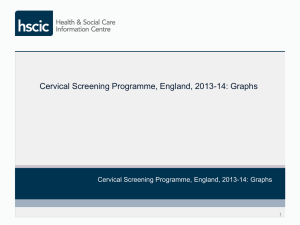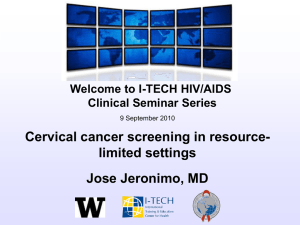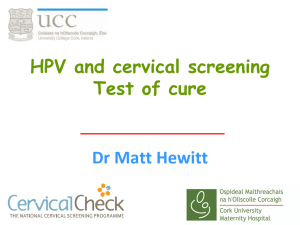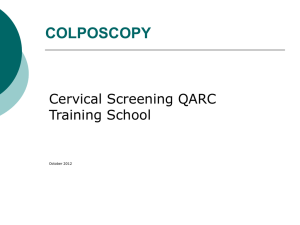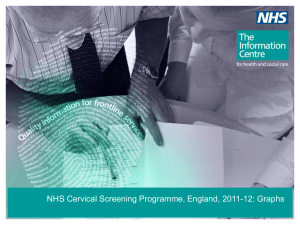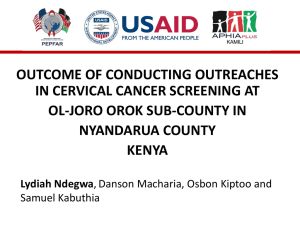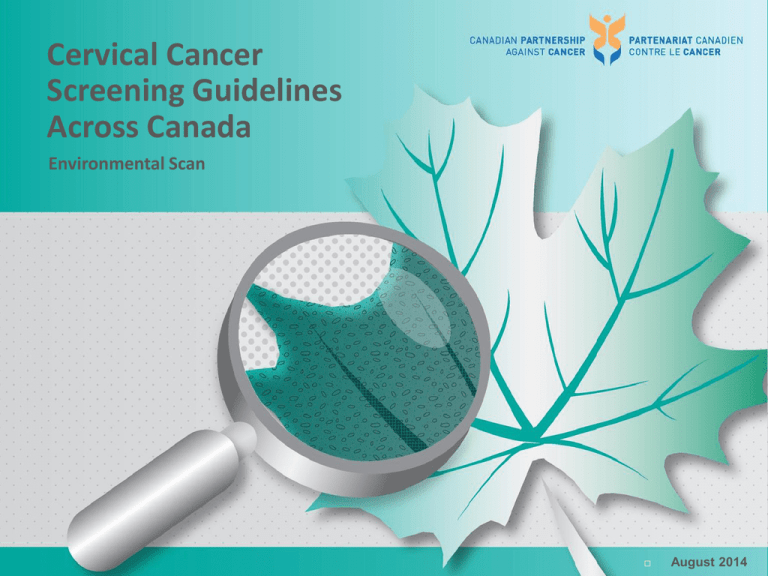
Cervical Cancer
Screening Guidelines
Across Canada
Environmental Scan
August 2014
Background
August 2014
Quarterly, the Canadian Partnership Against Cancer
collects information from the provinces/territories
and international organizations on the status of
population-based cervical cancer screening
programs and/or strategies.
This information compares current guidelines and
evidence-based recommendations in order to
identify leading practices.
Presentation Outline
August 2014
Canadian Task Force on Preventive Health Care
Guidelines
Provincial and Territorial Guidelines
Cervical Cancer Screening Programs in Canada
Follow-up Test for Abnormal Results
Detection Methods
Colposcopy Services or Standards Across Canada
HPV DNA Testing
HPV Immunization
Information Technology Solutions in Cervical
Screening Programs
Canadian Task Force on Preventive
Health Care Guidelines
The Canadian Task Force on Preventive Health Care (2013) recommends the
following for cervical cancer screening:
For women aged <20, routine screening not recommended (Strong
recommendation, high quality evidence)
For women aged 20 to 24, routine screening not recommended (Weak
recommendation; moderate quality evidence)
For women aged 25 to 29, routine screening is recommended every 3 years.
(Weak recommendation; moderate quality evidence)
For women aged 30 to 69, routine screening is recommended every 3 years.
(Strong recommendation; high quality evidence)
For women aged ≥70 who have been adequately screened (i.e. 3 successive
negative Pap tests in the last 10 years), routine screening may cease. For
women aged 70+ who have not been adequately screened should continue
screening until 3 negative test results have been obtained. (Weak
recommendation; low quality evidence)
For more information please visit: http://canadiantaskforce.ca/
Cervical Cancer Screening Programs:
Provincial and Territorial Guidelines
Start Age
Interval
Stop Age
Nunavut (NU)
Age 21 or 3 years post-first
sexual contact
Every 2 years after 3 consecutive
annual negative tests
Age 70 with 3 negative tests in previous
10 years
Northwest Territories
(NT)
Age 21 or 3 years post first
sexual contact, whichever occurs
first
Every 2 years after 3 consecutive
annual negative tests
Age 69 with 3 negative tests in previous
10 years
Yukon (YK)
British Columbia Cancer Agency
guidelines
British Columbia Cancer Agency
guidelines
British Columbia Cancer Agency
guidelines
British Columbia (BC)
Age 21 or 3 years post first
sexual contact, whichever occurs
first
Every 2 years after 3 consecutive
annual negative tests
Age 69 with 3 negative tests in previous
10 years or 3 annual negative tests (for
women inadequately screened)
Alberta (AB)
Age 21 or 3 years post first
sexual contact, whichever occurs
later
Within 5 years, with 3 negative tests
at least 12 months apart and then
continue every 3 years
Age 69 with 3 negative tests in previous10
years or 3 annual negative tests (for
women with no screening history)
Saskatchewan (SK)
Age 21 or 3 years post first
sexual contact, whichever occurs
later
Ever y 2 years until 3 consecutive
negative tests than every 3 years
Age 69 with 3 negative tests in previous10
years or 3 annual negative tests (for
women with no screening history)
Manitoba (MB)
Age 21 for all women who have
ever been sexually active
Every 3 years
Age 70 with 3 negative tests in previous
10 years
August 2014
Cervical Cancer Screening Programs:
Provincial and Territorial Guidelines, cont’d
Start Age
Interval
Stop Age
Ontario (ON)
21 years of age for women who are or
have ever been sexually active.
Every 3 years
Age 70 with adequate negative
screening history in previous 10
years (i.e. 3 or more negative tests)
Québec (QC)
Age 21
Every 2-3 years
Age 65 with 2 negative tests in
previous 10 years
New Brunswick (NB)
Age 21 or 3 years post first sexual
contact, whichever occurs later
Every 2 -3 years after 3 consecutive
annual negative tests
Age 69 with history of adequate
negative tests in previous 10 years or
3 annual negative tests (for women
with little/no screening history)
Nova Scotia (NS)
Age 21 or within 3 years of first vaginal
sexual contact whichever comes last
Every 3 years
Age 70 with adequate negative
screening history in the previous 10
years (i.e. 3 or more negative tests).
Prince Edward Island
(PEI)*
Age 21 if sexually active
Every 2 years
65 with adequate normal Pap history
in the previous 10 years
Newfoundland &
Labrador (NL)
Age 20
Every 3 years after 3 consecutive
annual negative tests
Age 70 with 3 negative tests in
previous 10 years or 3 consecutive
negative tests (for women with no
screening history)
** PEI guidelines revised October 2013
Cervical Cancer Screening Programs in
Canada
Program Start Date
Program Name
Agency Responsible for Program
Administration
Nunavut (NU)
N/A
Program not available
Northwest Territories
(NT)
N/A
Program not available
Yukon (YK)
N/A
Program not available
Government of Yukon
British Columbia (BC)
1960
Cervical Cancer Screening Program
BC Cancer Agency
Alberta (AB)
2003
Alberta Cervical Cancer Screening
Program
Alberta Health Services
Saskatchewan (SK)
2003
Prevention Program for Cervical
Cancer
Saskatchewan Cancer Agency
Manitoba (MB)
2000
CervixCheck
CancerCare Manitoba
Ontario (ON)
2000
Ontario Cervical Screening Program
Cancer Care Ontario
Québec (QC)
N/A
Program not available
Direction québécoise de cancérologie,
Ministère de la santé et des services
sociaux du Québec
New Brunswick Cervical Cancer
Prevention and Screening Program
New Brunswick Cancer Network (NB
Department of Health)
New Brunswick (NB)
2014-2015
Government of Nunavut
Department of Health & Social Services
Nova Scotia (NS)
1991
Cervical Cancer Prevention Program
Cancer Care Nova Scotia
Prince Edward Island
(PEI)
2001
PEI Pap Screening Clinic
Health PEI Funded. Administered by Dr.
D.I. Stewart.
Newfoundland and
Labrador (NL)
2003
Cervical Screening Initiatives Program
Cancer Care Program, Eastern Health
Cervical Cancer Screening Practices
Nunavut
4. No
Does the screening program send reminders for follow up after abnormal
Pap test results?
Northwest Territories
1. Yes to care providers only
Yukon
Information currently not
available
British Columbia
1. Yes to care
providers only
Alberta
1. Yes to care providers
and/or women
Not direct to patients. Cytology
lab sends follow-up letters to
clinicians for abnormal smears
on which they have not received
a follow-up smear within a
specific time frame.
Saskatchewan
1. Yes to care providers only
Manitoba
3. Yes, to women and care
providers
Ontario
4. Yes, to women only
Letters sent to providers and
women where recommended
follow up has not been performed
Nova Scotia
1. Yes, to care providers only
Reminder letters are sent to
the health care provider who
performed the pap test, when
recommended follow-up has
not been performed.
Prince Edward Island
3. Yes, to women and care
providers from lab services (not
program)
Quebec
4. No
New Brunswick
4. No
Abnormal Results
correspondence to primary
care providers and women
planned to begin
2014/2015
Newfoundland/Labrador
3. Yes to health care
providers, then women
Options
1.
Yes, to care providers only
2.
Yes, to women only
3.
Yes, to women and care providers
4.
No
And further comments (if any)
Cervical Cancer Screening Practices
Nunavut
Detection methods in routine use in cervical cancer screening programs
Northwest Territories
Liquid Based Cytology
Liquid Based Cytology
Reflex HPV testing for
ASCUS in women ages >30
HPV triage for certain
Pap test abnormalities
Saskatchewan
Manitoba
Conventional cytology
Nova Scotia
Conventional cytology and
one district who is piloting
Liquid Based Cytology
testing
Conventional cytology
and liquid based
cytology
Yukon
British Columbia
Conventional cytology
Alberta
Liquid Based Cytology
HPV triage for certain
Pap test abnormalities**
Ontario
Quebec
New Brunswick
Liquid Based Cytology
Conventional cytology
Liquid Based Cytology
Liquid Based Cytology
and conventional
cytology
HPV triage for certain Pap
test abnormalities* (not an
insured service)
HPV triage for certain Pap
test abnormalities.
HPV triage is already
available in some
laboratories and will be
made available for all
ASCUS related cases in
the entire province by
2014
HPV triage for certain
Pap test abnormalities**
Prince Edward Island
Newfoundland/Labrador
Conventional cytology
Liquid Based Cytology
*triage in case of ASC-US/borderline dyskaryosis only
**triage in case of ASC-US/ borderline dyskaryosis or
LSIL/ mild dyskaryosis
Reflex HPV testing for
ASCUS in women >30
years old
Cervical Cancer Screening Practices
When is a woman sent for a referral to colposcopy in your cervical cancer
screening program?
Colposcopy
Result
NU
NT*
YK
BC
AB
SK
MB
ON
QC
NB
NS
PEI
NL
ASC-US/borderline
dyskaryosis (1st
result)
(LSIL Age
>30)
LSIL/mild
dyskaryosis (1st
result)
Age >30 &
2nd result 2130*
(for
In women >
21 years of
age
AGC
HSIL+
* Refer to
Territorial
Guideline
persistent
ASCUS/LSIL
for 2 years
women
>/=50
years LSIL and
HPV +
result
Postcoital
bleeding
or
cervicitis
women >
50 years
with
LSIL and
HPV +
result
ASC-US and HPV+
result
Repeated ASCUS/LSIL after
previous ASCUS/LSIL
Other:
(for
women
>/= 30)
women
>/= 30
yrs)
Persistent
Unsat
results due
to
inflammation or
obscuring
blood
LSIL
repeat in
6 months
with
ASCUS
=colposc
opy
Colposcopy Services or Standards Across
Canada
Province/
Territory
How are colposcopy services provided in your province/territory (e.g. Are there any
formal programs, what facilities are delivering colposcopy services)?
NT
No formal program for colposcopy, but referral to Ob/Gyn. Only Ob/Gyns perform colposcopy for entire territory
BC
The Provincial Colposcopy Program consists of 24 hospital-based clinics located throughout BC. Colposcopists affiliated
with the Provincial Colposcopy Program are certified and have agreed to use a uniform reporting system with standardized
terminology.
AB
Sixty-one colposcopists work out of 34 colposcopy clinics / sites participating and submitting colposcopy report forms to
the ACCSP
SK
Colposcopy services are provided by individual practitioners, which includes gynecologic oncologists as well as general
gynaecologists.
MB
4 formal colposcopy clinics (2 rural, 2 in wpg) based out of hospitals, remaining colposcopy services are in private offices
ON
Colposcopy services are provided by individual practitioners, including general gynecologists and gynecologic oncologists.
QC
Colposcopy services are conducted in hospital settings. Referrals are done by the hospital and there are no formal
programs.
NB
Colposcopies are provided by each of the 8 regional hospitals across NB. Colposcopies are operationalized by the
Regional Health Authorities.
NS
Colposcopy is delivered in NS primarily in hospital based clinics. There are a few private office based clinics that provide
initial assessment with treatment performed in a hospital setting.
PEI
Colposcopies are done through a referral to a Gynaecologist. They are mostly conducted in the OB/GYN offices.
NL
Colposcopy services are provided in eleven sites within the four regional health authorities. There are also some
colposcopy services available in private practice. A comprehensive environmental scan of colposcopy services is underway
with a plan in development for next steps based on best practice models.
Colposcopy Services or Standards Across
Canada
Which colposcopy services/standards are offered in your province/territory (check
all those that apply)
Province/
Territory
Training Programs
(please specify)
CME certification
opportunities (please
specify)
NT
Collection of quality indicators
related to colposcopy (please
specify)
Other (please specify)
Same indicators collected as
Alberta but not recorded centrally
BC
Certified through the
Provincial Colposcopy
Program
AB
All physicians doing
colposcopy in Alberta meet
College of Physicians and
Surgeons of Alberta
(CPSA) education
standards
SK
No formal training
programs
MB
limited
*Nunavut and Yukon excluded due to no data available
ACCSP sponsors
Annual Colposcopy
meeting accredited by
the Royal College of
Physicians and
Surgeons of Canada
The ACCSP Colposcopy Quality
Improvement Committee has
identified three Colposcopy Quality
Practices (CQP) and eight
Colposcopy Quality Measures
(CQM) as detailed in the
Colposcopy Component – ACCSP
Quality Management Program
Documentation
CervixCheck collects and
distributes colposcopy quality
indicator reports to all MB
colposcopists which include, a) time
to colposcopy, and b) impressionhistology correlation.
Standards also supported
by the Society of
Obstetricians and
Gynaecologists of Canada
Colposcopy Services or Standards Across
Canada, cont’d
Which colposcopy services/standards are offered in your province/territory (check all those that apply)
Province/
Territory
Training Programs
(please specify)
CME certification
opportunities (please
specify)
ON
Collection of quality indicators
related to colposcopy (please
specify)
Scheduled to begin collecting data
to support indicators April 2014.
QC
certain residency
programs in gynecology are
offered 3 months of training
dedicated to colposcopy
certain professional
associations offer such
certifications (AOGQ,
SPGQ, GOC,
ASCCP)**
NB
Responsibility of the
Regional Health Authorities
Responsibility of the
Regional Health
Authorities
Varies per Regional Health
Authority
Colposcopist Working
Day (CME credits)
Colposcopist performance reports.
*For details see below
NS
Program is planning to
collect basic data of
Colposcopy service date
by 2014/2015.
N/A – completed through
OB/Gyn offices
PEI
NL
Other (please specify)
3 performance indicators
* NS: Colposcopy Histopathology vs. Visual Follow Up Visit and Zoneseen = Yes - By Physician and Aggregate; Colposcopy Pre-Treatment Biopsy Result vs.
Treatment Result – By Treatment - By Physician and Aggregate; Treatment Success By 12 Month Post Treatment Result – By Treatment - By Physician and
Aggregate; % of ECC’s Performed By Physician and Aggregate
**Association des obstétriciens et gynécologues du Québec (AOGQ); Société des obtétriciens et gynécologues du Canada SPGQ, (SOGC); Society of
Gynecologic Oncologists of Canada (GOC); American Society for Colposcopy and Cervical Pathology (ASCCP).
HPV DNA Testing
Nunavut
Aids triage in women
>30 with ASCUS on
Pap
Saskatchewan
2. Personal request
(only)
3. Pilot trials/Research
Nova Scotia
3. Pilot trials/Research
August 2014
Is the use of HPV DNA testing a standard of practice in your province or
territory? If yes, in what capacity is it being used?
Northwest Territories
3. Pilot trials/ Research
4. Follow up for treatment
5. Triage in women > 30
with ASCUS or
postmenopausal women
with LSIL/ASC-US
Manitoba
3. Pilot trials/Research
Prince Edward Island
2. Personal Request (only)
at the cost to the woman.
Guidelines suggest HPV
testing following a ASCUS
for women over 30 but not
funded at this time.
Yukon
Information currently not
available
Ontario
British Columbia
3. Pilot
trials/Research
4. Follow up for
treatment
Quebec
Alberta
4. Triage in women > 30
with ASCUS or women >
50 with LSIL. (HPV triage)
New Brunswick
3. Pilot trials/Research
3. Triage in women >
30 with ASCUS in
2014
Newfoundland/Labrador
Options
1.
Routine primary screening
2.
Personal request (only)
3.
Pilot trials/Research
4.
Follow up for treatment
5.
Other (specify)
4. ASCUS Triage for
women over 30 years of
age
4. Triage in women > 30
with ASCUS or women >
50 with LSIL
HPV Immunization
Province/
Territory
Immunization program details ( Check all those that apply)
Are adverse
effects reported?
Are vaccines available
outside program?
NU
NT
Is there a catch-up
strategy?
Is there a schoolbased strategy?
Grade 6 girls only
Is there a committee
in place?
A general NWT Advisory
Committee on Immunization
YU
BC
AB
Determined by each
regional health authority
(boys will be included
fall 2014
SK
MB
ON
QC
NB
NS
(commercially available for
purchase)
Personal request and paid by
PEI
(boys will be included fall
woman
NL
Chief Public Health Officer
2013)
HPV Immunization:
Date , age first cohort immunized and catch-up
Nunavut
Northwest Territories
Yukon
British Columbia
Alberta
Date
2010
Fall 2009
November 2009
December 2008
December 2008
Age
Grade 6 or >/= 9
yrs old
Grade 4, 5 or 6
Grade 6
Grade 6, 9
Grade 5
A three year catch-up
starting with Grades 11&
12 in 2009/10 , Grades 10&
11in 2010/11, Grades 9&10
in 2011/12 and ending with
Grade 9 in 2012/13 &
2013/14
Grades 7 and 8 catch-up
Catch-up
Saskatchewan
Manitoba
a three-year catch-up
offered to Grade 9
(ages 14 – 15) girls
starting (2009/2010
school year)
Ontario
Quebec
New Brunswick
Date
December 2008
December 2008
December 2007
September 2008
December 2008
Age
Grade 6
Grade 6
Grade 8
4th year (age 9-10) of primary
school, and girls under 18 in
the general population (+
immunosuppressed woman
up to 26 years of age). Since
May 2014, the vaccine is
available for boys ages 9-26
who are immunosuppressed
and infected with HPV.
Grade 7
Females who missed the
vaccine in gr 6 and are born
on or after January 1, 1997.
Females born between 1986
and 2005 with increased risk
of HPV infection who started
the vaccine series before
March 31, 2014.
In 2012, the catch-up
program was revised so
that females who did not
complete, or who did not
receive, the HPV vaccine
series in grade 8 are
eligible to complete the
series by end of grade 12
The catch-up program for
girls of 3rd year of secondary
school (age14-15) ended in
June 2013. However, the
vaccine is still systematically
offered to partially or
unvaccinated females.
Females who did not
receive or complete
the series of HPV
vaccine in grade 7 are
eligible to complete the
series until the end of
grade 12
Catch-up
August 2014
HPV Immunization:
Date , age first cohort immunized and catch-up
Nova Scotia
Prince Edward Island
Newfoundland/Labrador
Date
2007
2007
December 2007
Age
Any female born after
October 1st 1993 and
previously missed or
refused HPV
immunization,
Female Grade 7
students when
provided through the
school program
Grade 6
*Fall 2013, Grade 6
boys to be included.
All girls born since 1994
have been offered the
vaccine, offered to grade
6 females.
Catch-up
2009-2010, Grade 10
August 2014
*vaccinations offered to a cohort of boys
2008-2009, Grade 9
catch-up offered to girls
August 2014
HPV Immunization:
Size of population & 1st dosage received
Nunavut
Northwest
Territories
Yukon
British Columbia
Alberta
Size of population
(Current)
Information
currently not
available
Approximately 900
girls would be in the
Grade 4, 5 & 6
cohort
Information
currently not
available
2011-12:21460
2012-13: 21285
2013-14: 21071
Information may be
obtained from
Population and Public
Health of Alberta Health
Services
Number to receive
first dose (or
estimate)
(current)
Information
currently not
available
HPV coverage
estimates among
grade 7 girls, NWT
2009/10 – 46%
2010/11 - 38%
2011/12-44%
2012/13-30%
2013/14-47%
Information
currently not
available
GR 6: 2009 61.8%, 2010
59.9%, 2011 68.2%, 2012
68.7%, 2013=69.1%
GR 9: 2009 62.1%, 2010
58.1%, 2011 61.7%, 2012
and 2013=uptake results
are included in the grade 6
results for 2009 and 2010
as these girls were
provided with their 3rd
dose when they were in
grade 6.
Numerator includes girls
who received the vaccine
through a school based
public health program.
2010-2011
GR 5: receiving series
of 3 doses of HPV is
60.2%,
GR 9: receiving series
of 3 doses of HPV is
60.1%
August 2014
HPV Immunization:
Size of population & 1st dosage received, cont’d
Saskatchewan
Size of population
(current)
Information
currently not
available
Manitoba
Eligible HPV vaccine
cohort size is 8,000
Ontario
GR 8
Quebec
Fourth grade: 36225
New Brunswick
Eligible girls in GR 7 and 8 in
public school (2008-2009)
Eligible Girls in GR 7 in public
school since 2010
Number to receive
first dose (or
estimate)
(current)
73% GR 6 girls
received at least 1
dose
Ranges from 65% of
eligible cohort in 2009
to 72% of eligible
cohort in 2012. As of
Aug 1st, 2014, 67.8%
of females received 1st
dose for 2013/14
school year.
HPV coverage estimate for
2012–13 is 80.2%
Nova Scotia**
Prince Edward Island
Newfoundland/
Labrador
Size of population
(current)
GR 7 –approximately
5000
GR 6 girls
Boys start 2013.
2500 GR 6 girls (from
2007-present)
2500 Grade 9 girls (in the
two catch-up years
2008/09 and 2009/10)
Number to receive
first dose (or
estimate)
(current)
Coverage rate** for
the 2012-2013
school year
First dose=93.5%
All 3 doses=77%
Estimate – 80%
First dose=92% GR 6; 84%
coverage GR 9.
1st dose: 30 021 (83%) girls
and 2nd dose: 28 578
(77,5%)
* Data from school-based
vaccination campaigns in
2013-2014 (August 22,
2014)
2008-9: 72.8% rec’d complete
series, 5.6% incomplete
2009-10: 71.2% rec’d complete,
series 5.6% incomplete
2010-11: 73 % rec’d complete
series, 4.7%Incomplete
2011-12: 75.8% rec’d complete
series, 3.3 % incomplete
2012-13: 75.2% complete
series, 5.1% incomplete
2013-2014 – Stats unavailable
until August 2014
*GR = school grade
**For Nova Scotia **Unpublished data
HPV Immunization
Registry/
Database
NU
Does you cervical cancer screening program collect information for the following:
NT
YK
BC
AB
SK
MB
ON**
QC
NB
NS
PEI**
NL
*
*
***
Number of doses
Age at vaccination
Age at each dose
(will
(Under
evaluati
on)
(will
collect
by
2015)
collect
by 2014)
HPV vaccination
status
HPV vaccine type
(quadrivalent/
bivalent)
Participation rates
by HPV
vaccination status
(planning phase)
(Under
evaluati
on)
(will
collect
by
2016)
* Through self-report data & school-based immunization program/ HPV School based registry (Public Health)
** This information is not collected by the screening program but could be collected through Public Health Records
***Through medical record data
Information Technology Solutions Used in
Cervical Cancer Screening Programs
Which IT system/solution do you currently use in your cervical cancer screening program?
Province/
Territory
Name of Information Technology System/Solution
NT
Manual only. No system
BC
IT system was developed in house.
AB
Alberta Cervical Cancer Screening application and colposcopy databases contains all records of referral cytology
SK
Integrated Screening Information System or ISIS
MB
ISIS-CSP – Artificial Intelligence in Medicine
ON
Cytobase
QC
Cervical cancer screening is opportunistic and therefore, there is no cervical cancer screening program nor is there an
information system. Since 2013, data on high-grade cervical lesions are collected through the Quebec cancer registry.
NB
Custom Designed Solutions– CCPSR (Cervical Cancer Prevention & Screening Repository) and CS-IIS (Cancer Screening
– Integrated Information System)
NS
Ccasper (Oracle relational database)
PEI
N/A – no IT system at this time
NL
ISIS
August 2014
First Nations, Inuit & Métis Strategies
and Data Collection
Do you collect First Nations, Inuit, and/or Métis cervical cancer data in your
screening program (e.g. is there a FNIM identifier at the individual level in your
screening database)? Do you have strategies/studies pertaining to such
populations? If so,
Province/
Territory
Are FNIM data
being collected
(Yes/No)?
If ‘Yes’, what data are being collected and for
which population
(list variables below)?
Which FNIM based strategies/studies have been
implemented (provide details below)?
Nonaboriginal, Dene, Metis and Inuit
mammography screening uptakes
No, all health services in NWT are delivered in an
integrated fashion. We do not have separate
strategies
NU
NT
YK
BC
Yes
First Nations, Inuit & Métis Strategies
and Data Collection
Do you collect First Nations, Inuit, and/or Métis cervical cancer data in your
screening program (e.g. is there a FNIM identifier at the individual level in your
screening database)? Do you have strategies/studies pertaining to such
populations? If so,
Province/
Territory
Are FNIM data being
collected (Yes/No)?
If ‘Yes’, what data are being collected
and for which population
(list variables below)?
Which FNIM based strategies/studies have been
implemented (provide details below)?
Individual level – No
Community level – Yes
through Enhanced
Access to Cancer
Screening (EACS) pilot
project. Served 9
FNIM communities and
will reach an additional
5 before the project is
over
EACS related service data
-# of FNIM communities/yr
-clinic attendance for cervical screening,
-Alberta Cervical Cancer Screening Program has
SK
Yes
We identify if a women has federal status
Education and promotion at First Nation events and
health fairs to inform about screening
MB
No
AB
developed culturally appropriate educational
resources for the FNIM population which are
available via www.screeningforlife.ca and in print.
-Enhanced Access to Cancer Screening (EACS)
Project is +being piloted to provide cervical and
colorectal cancer screening in tandem with the ST
mobile mammography service in several FNIM
communities.
Partners with First Nation Metis Inuit Cancer
Control Program, CCMB, First Nations Inuit Health
Branch and Northern Nursing Stations and
communities for all First Nation recruitment and
education activities.
First Nations, Inuit & Métis Strategies
and Data Collection Cont’d
Do you collect First Nations, Inuit, and/or Métis cervical cancer data in your screening
program (e.g. is there a FNIM identifier at the individual level in your screening
database)? Do you have strategies/studies pertaining to such populations? If so,
Province/
Territory
ON
Are FNIM data
being collected
(Yes/No)?
No
If ‘Yes’, what data are being
collected and for which population
(list variables below)?
Which FNIM based strategies/studies have been implemented (provide
details below)?
N/A
•
Anishinabek Cervical Cancer Screening Study (ACCSS) – led by
Thunder Bay Regional Research Institute; CCO has supported the KTE
and advised on the sustainability of the participatory action research
project investigating the factors underlying the cervical cancer burden in
First Nation women in Northwestern Ontario
Initiatives being implemented across the colorectal, breast, and cervical
cancer screening programs:
• Improving Cancer Screening among First Nations and Métis
Communities research project – collaboration between CCO’s ACCU and
Sunnybrook Research Institute (SRI); funded by CIHR and CCO; over 3
years, project will develop a comprehensive action plan to improve cancer
screening among high density First Nation and Metis communities; the
action plan will draw on findings from related project aims: an analysis
of cancer screening health policy, community based cancer screening
research, and evaluation of Under/Never Screened initiatives
• Building regional capacity to address FNIM cancer screening through the
development Regional Aboriginal Cancer Plans. The plans were
developed through direct engagement and feedback from the FNIM
communities, the Regional Cancer Programs and CCO. An example of
an initiative from a plan includes opportunities to address access to
screening using existing Mobile coaches and clinics to reach remote and
underserved FNIM communities.
• Developed a recommendation report to build organizational capacity and
plan to develop FNIM identifiers to inform and support cancer screening;
• Supported and informed the 4 Under/Never Screened regional pilots to
address screening rates with FNIM communities
First Nations, Inuit & Métis Strategies
and Data Collection Cont’d
Do you collect First Nations, Inuit, and/or Métis cervical cancer data in your
screening program (e.g. is there a FNIM identifier at the individual level in your
screening database)? Do you have strategies/studies pertaining to such
populations? If so,
If ‘Yes’, what data are being collected
and for which population
(list variables below)?
Province/
Territory
Are FNIM data
being collected
(Yes/No)?
QC
N/A
NB
No
N/A
NS
No
However, CCNS provides screening and other
cancer related data to several first nations
communities in Nova Scotia through linkage
with the First Nations Client Registry (unique in
Canada). Success of this work has led to an
expanded project: Strengthening Numbers
Project - Improving Aboriginal Health
Information for Nova Scotia First Nation
Communities.
Strategy under development for hard-to-reach
population
CCNS also collaborates with First Nations and
Inuit Health, Health Canada and Tui’kin
Partnership regarding educational resources
for cervical cancer screening.
PEI
No
NL
Not available
Which FNIM based strategies/studies have
been implemented (provide details below)?
N/A
Reference Slide
Please use the following reference when citing
information from this presentation:
Cancerview.ca. Cervical Cancer Screening Guidelines
Across Canada: Environmental Scan. Toronto:
Canadian Partnership Against Cancer; [enter date].
Available from: [enter URL link]
August 2014


